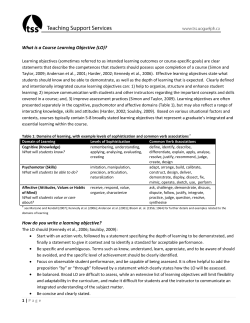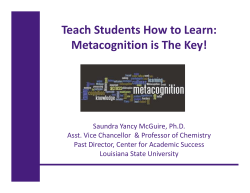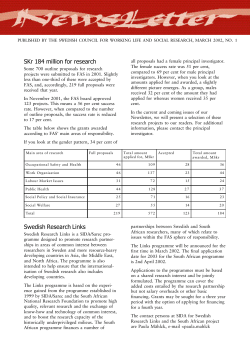
Why taxonomy matters Johan Liljeblad Ulf Gärdenfors Swedish Species Information Centre
Why taxonomy matters Johan Liljeblad Ulf Gärdenfors Swedish Species Information Centre Why is taxonomy important? Because taxonomy is • a language for communication • an essential infrastructure for other activities in society Imagine if people and things didn’t have a name… ? … or if many names were wrong ”Oskar” ? Anton Marta Emelie Emma Anna ? ? Cecilia Sofia ? Linus? Johan ”Clara” Linnea Petra A typical taxon in need of revision Krtek a medicína (1987) Zden!k Miler Matricaria recutita Chamomilla recutita Matricaria chamomilla Matricaria suaveolens Chamomilla suaveolens Taxonomy – an important language If a researcher doesn’t have a reliable name on her study object, it is impossible to communicate and publish on the results Taxonomy – an important language Researcher A: “Glomerus marginata produces homoglomerin” Researcher B: “Glomerus marginata produces acetoquinazolinone” If the taxonomy is poor, studies may be conducted on different taxa but reported by the same name – creates confusion Black Bug in the Philippines One species -> 11 species + life history. Only 3 act as pests, developing in stubble. The use of insecticides could be reduced considerably. Malaria mosquitoes in Europe Malaria mosquito Anopheles maculipennis Entire Europe North Europe Possible vector North- and Central Europe No vector European mountains No vector Mediterranean area No vector Mediterranean area No vector South Europe Important vector Eastern Important vector Mediterranean Cassava mealybug Phenacoccus manihoti Cassava (manioc or tapioca) Anagyrus (Epidinocarsis) lopezi Project cost $30 mil, revenue $8-20 billion, i.e. 200x Taxonomy – an important language Taxa with poor taxonomy may not even be possible to do research on. Taxonomy – an important language Taxa with poor taxonomy may not even be possible to do research on. The funding to biodiversity research from research councils is heavily dominated by support to vertebrates and vascular plants. Taxonomy – an important language Taxa with poor taxonomy may not even be possible to do research on. The funding to biodiversity research from research councils is heavily dominated by support to vertebrates and vascular plants. What interesting theories, processes and use of goods do we miss because of that? Taxonomy – an essential infrastructure for other fields Research • Every field of basic biological research: ecology, physiology, biotechnology, genetics • Pharmaceutical research • Human and veterinary medicine Taxonomy – an essential infrastructure for other fields Research • Every field of basic biological research: ecology, physiology, biotechnology, genetics • Pharmaceutical research • Human and veterinary medicine Use of biodiversity (poor taxonomy may kill!) Taxonomy – an essential infrastructure for other fields Research • Every field of basic biological research: ecology, physiology, biotechnology, genetics • Pharmaceutical research • Human and veterinary medicine Use of biodiversity (poor taxonomy may kill!) Taxonomy – an essential infrastructure for other fields Research • Every field of basic biological research: ecology, physiology, biotechnology, genetics • Pharmaceutical research • Human and veterinary medicine Use of biodiversity (poor taxonomy may kill!) Monitoring & conservation of environment Taxonomy – an essential infrastructure for other fields Research • Every field of basic biological research: ecology, physiology, biotechnology, genetics • Pharmaceutical research • Human and veterinary medicine Use of biodiversity (poor taxonomy may kill!) Monitoring & conservation of environment Biological pest control Control of invasive species Linnaeus estimated that there are 26,500 species world-wide Since the 18th century we have learned that… • …the speed of light is 299,729,458 m/s • …the average distance to the moon is 384,403 km • …the sun weighs 1.989 x 1030 kg • …the emission from caesium133 oscillates at 9,192,631,770 Hz during the transition between two particular energy levels ! But… ? …we still have no idea how many species there are on earth • 2 million? • 20 million? • 200 million? We don’t even know how many species we have found and described Global databases today contain 1,160,711 species The probable answer lies between 1.5–2.0 million described species Known species in Sweden Vertebrates AlgaeFungi Other invertebrates Mosses Other invertebrates Fungi Vasc. plants Algae Linnaeus 3,559 species Fungi Bryophyta Bryophyta Vascular plants Vascular plants Arthropods Other invertebrates Arthropods Algae Fungi Vertebrata Arthropods Arthropods Other invertebrates Vertebrata 2002 50,200 (+13,000) species Insects in Sweden Preda-Saprotors phages Parasites Phytophages Phytophage parasites Parasites Tullgren & Wahlgren 1922 Predators Other Phytophages Saprophages Ronquist et al. 2008 Saprophage parasites Phytophage parasites Unspecialized parasites From: F. Ronquist, M. Forshage, R. Hovmöller, D. Karlsson, K. Glemhorn & J. Liljeblad Taxonomy Impediment Lack of good taxonomy and skilled taxonomists is an impediment for society Why an impediment? Difficult to compete as a regular science within the university and research council systems of ranking New taxa in high-ranking journals In Science and Nature only 4 arthropods n.sp. have been published during the last 20 years: – A new order (Mantophasmatodea) – A new major pest – a whitefly (demonstrated by a battery of high tech) – An unusual physiology (on a Himalayan glacier) – A correction for a nomen nudum in a report on a snail-eating caterpillar Taxonomy Impediment Lack of good taxonomy and taxonomists is an impediment for the society We must transform the impediment to an expedient Taxonomy Expedient Taxonomists need to be more active towards the society • Communicate to society the importance of taxonomy infrastructure Compare: Medical care Schools Roads and railways IT, e.g. telephone, broadband Taxonomy Expedient Taxonomists need to be more active towards society • Communicate to the society the importance of taxonomy infrastructure • Promote taxonomy Taxonomy Expedient Taxonomists need to be more active towards society • Communicate to the society the importance of taxonomy infrastructure • Promote taxonomy • Assist the society in it’s need of taxonomic help – share your knowledge Make taxonomic information accessible • Publish open access • Deposit gene sequences and illustrations in accessible databases • Assist completing taxonomic databases • Enter data about material in accessible databases • Make older descriptions available in databases Classic taxonomy still important Morphological descriptions, type designations and identification keys are still needed Convention on Biological Diversity (CBD) Convention on Biological Diversity (CBD) Article 7. Identification and Monitoring Each Contracting Party shall: (a) Identify components of biological diversity important for its conservation and sustainable use; (b) Monitor the components of biological diversity identified pursuant to (a); (c) Identify processes and categories of activities which have significant adverse impacts on the conservation and sustainable use of biological diversity, and monitor their effects; and (d) Maintain and organize data derived from identification and monitoring activities pursuant to (a), (b) and (c). Convention on Biological Diversity (CBD) Article 8. In situ-conservation Each Contracting Party shall: c) Regulate or manage biological resources important for the conservation of biological diversity with a view to ensuring their conservation and sustainable use; (h) Prevent the introduction of, and control or eradicate those alien species which threaten ecosystems, habitats or species Convention on Biological Diversity (CBD) Article 12. Research and training Each Contracting Party shall: (a) Establish programmes for scientific and technical education and training in measures for the identification, conservation and sustainable use of biological diversity; (b) Promote research which contributes to the conservation and sustainable use of biological diversity Taxonomy Initiatives ”Governments, through the Convention on Biological Diversity, have acknowledged a taxonomic impediment to the sound management of biodiversity, and have developed the Global Taxonomy Initiative to remove or reduce the impediment.” Swedish Taxonomy Initiative The Swedish Taxonomy Initiative (Svenska artprojektet) Aims at charting and describing the entire Swedish fauna and flora (>50,000 species) within 20 years, as well as describing them in a popular science encyclopedia (Nationalnyckeln) The Swedish Taxonomy Initiative (Svenska artprojektet) Commissioned by the Swedish Parliament 2002 Hosted and directed by The Swedish Species Information Centre (ArtDatabanken) Swedish Taxonomy Initiative Inventories Taxonomic revisions Popular science encylopedia Taxonomic research "6 million granted 2002–2008 Taxonomic research & inventories Has so far resulted in • 2000 species new to Sweden • out of which 750 are new to science! The Encyclopedia of the Swedish Flora and Fauna • Popular science presentation of multi-cellular species in Sweden/Nordic countries • In Swedish, important facts and identification keys in English • High-quality illustrations • Ca. 100 volumes planned Next volume – Hoverflies Syrphidae Hans Bartsch m.fl. Ill: Elisabeth Binkiewicz Why a Taxonomy Initiative? • Builds taxonomy capacity • Support for research, nature conservation and species monitoring • Makes the entire flora and fauna accessible to everyone • Enhances awareness and possibilities for schools and the general public • Fulfillment of international obligations and a contribution towards charting the worlds flora and fauna The deliverables of STI • Complete taxonomic revisions • Popular science handbooks: ca. 100 vol. of an Encyclopedia of the Swedish Flora and Fauna • Taxonomic infrastructure • Reinforced museums • Better knowledge of species biology and conservation status Norway has started a taxonomy initiative 2009 in close cooperation with Sweden It could be done on a European level as well! What must be done in the EU? Research strategy recommendations: • build-up of taxonomy as an essential infrastructure for society • taxonomy initiatives to chart and describe entire flora and fauna • support to taxonomy needs to be targeted since it can't compete in the traditional peer review system • also support to and collaboration with developing countries outside of the EU Research priority recommendations: • educate and employ taxonomists, incl. research schools, with a focus on poorly known taxa • support to natural history (research) museums • support to ICT (Information and Communications Technology) systems for names, descriptions, observations/collections
© Copyright 2025
















